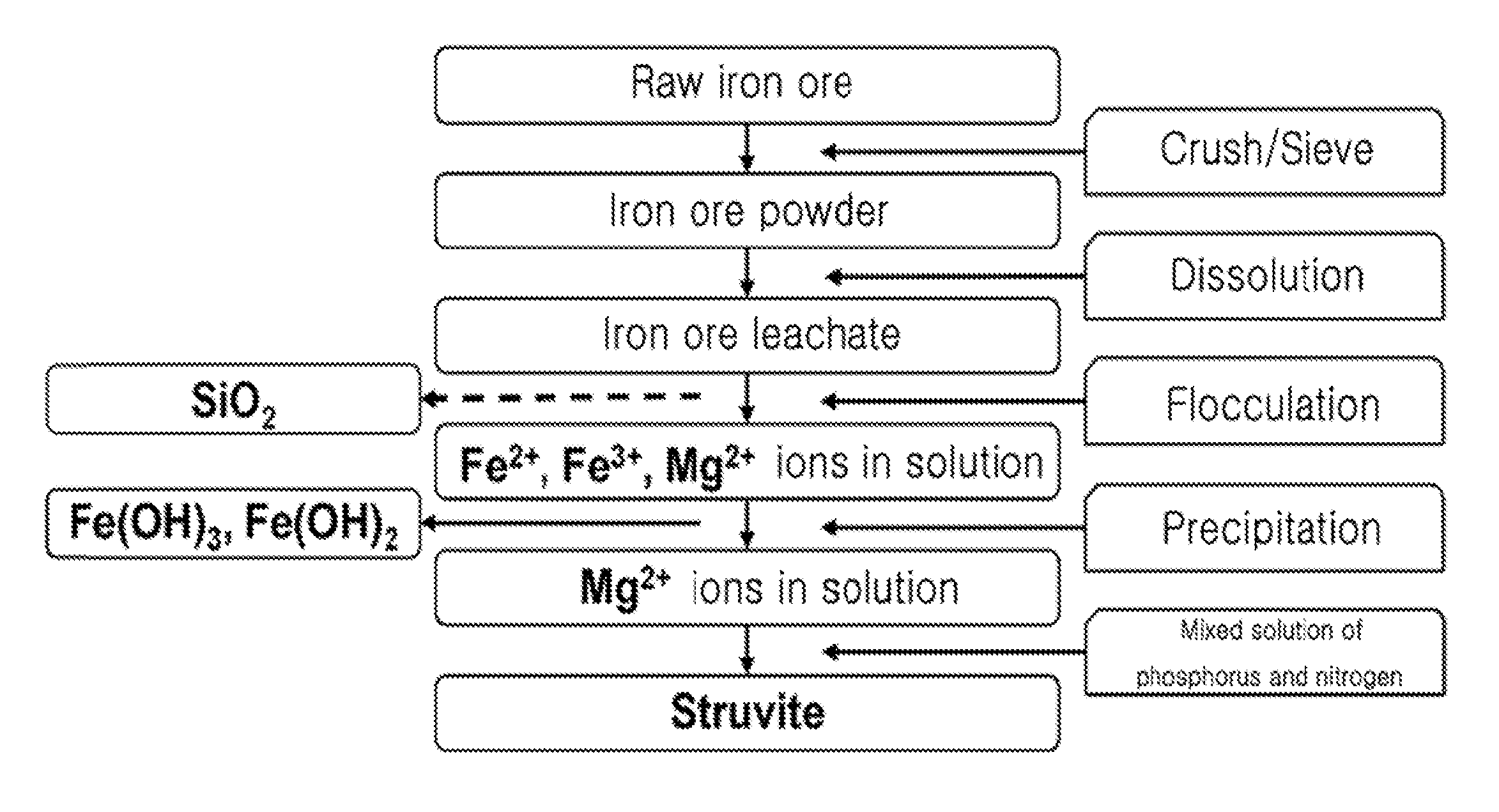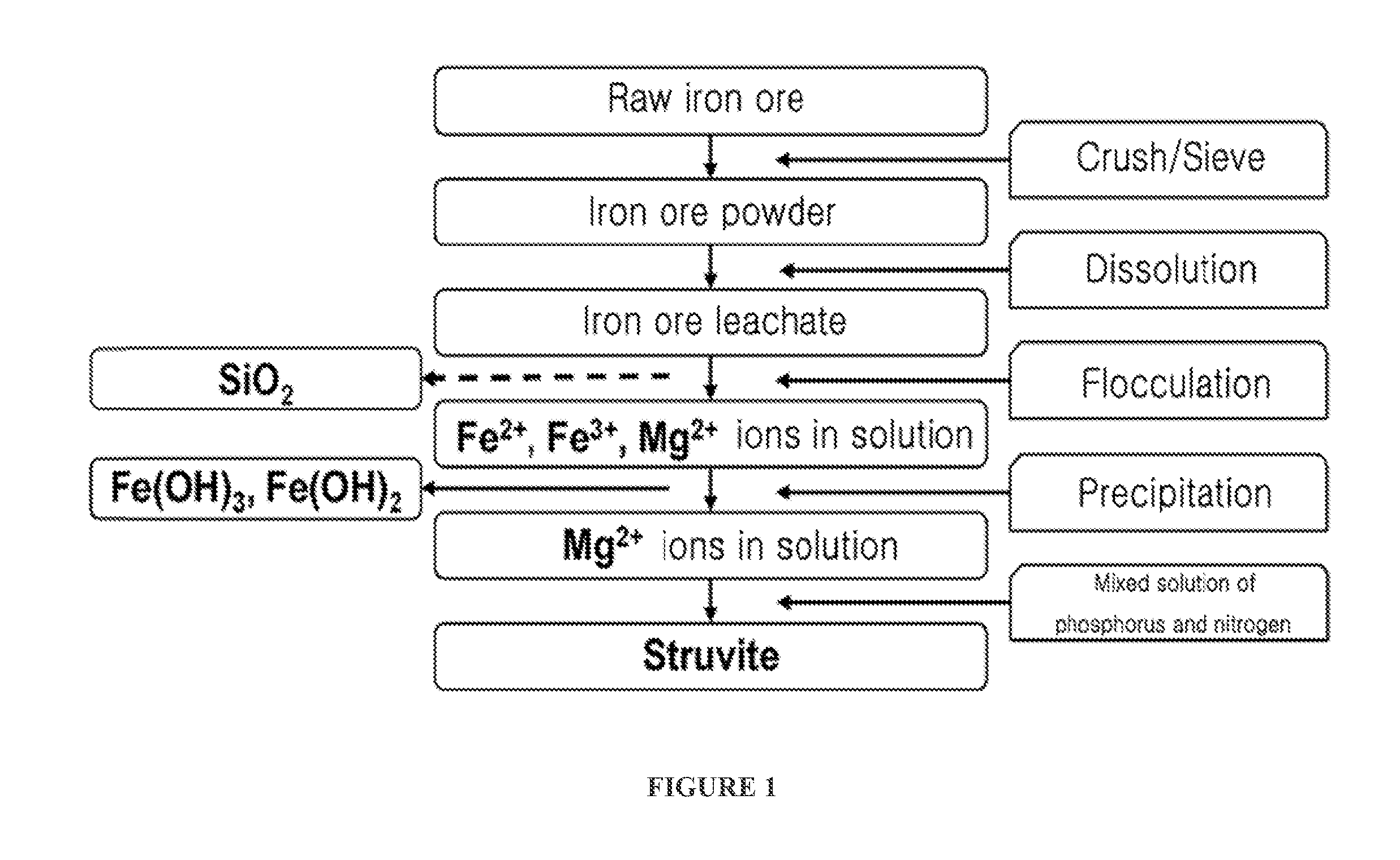Method for Removing Phosphorus and Nitrogen Contained in Sewage or Wastewater Using Iron Ore Wastewater
a technology of iron ore and phosphorus, which is applied in the direction of multi-stage water/sewage treatment, quary waste water treatment, separation process, etc., can solve the problems of accelerating water pollution, reducing the efficiency of cultivation repeated, and reducing soil degradation, so as to achieve phosphorus removal efficiency about 90% or higher, phosphorus removal efficiency is about 99% or higher, and phosphorus removal efficiency is almost the same
- Summary
- Abstract
- Description
- Claims
- Application Information
AI Technical Summary
Benefits of technology
Problems solved by technology
Method used
Image
Examples
example 1
Method for Removing Phosphorus and Nitrogen Contained in Sewage or Wastewater Using Iron Ore Wastewater
[0041]1. Preparation of Hydrochloric Acid Leachate (Wastewater Including Mg2+ as Main Component) Containing Silica From Raw Iron Ore
[0042]After raw iron ore was crushed, iron ore powder less than 149 microns was sieved through a No. 100 sieve. 25 g of sieved iron ore powder and 100 ml of 4 M hydrochloric acid were placed in a 1 L beaker and stirred at 100° C. for 2 hours, thereby obtaining iron ore leachate. 100 ml of distilled water was added to the iron ore leachate to be diluted, and the resulting iron ore leachate was centrifuged at 10,000 rpm for 10 minutes to separate and discharge residual undissolved powder. A 2 M NaOH solution was slowly added to the iron ore leachate to be neutralized to a pH of 8. The resulting leachate was centrifuged at 10,000 rpm for 10 minutes to obtain a precipitate of iron hydroxide and a supernatant containing Mg2+. The iron hydroxide was used as ...
example 2
Method for Removing Phosphorus and Nitrogen Contained in Sewage or Wastewater Using Iron Ore Wastewater
[0048]1. Preparation of Hydrochloric Acid Leachate (Wastewater Including Mg2+ as Main Component) Containing No Silica From Raw Iron Ore
[0049]After raw iron ore was crushed, iron ore powder less than 149 microns was sieved through a No. 100 sieve. 25 g of sieved iron ore powder and 100 ml of 4 M hydrochloric acid were placed in a 1 L beaker and stirred at 100° C. for 2 hours, thereby obtaining iron ore leachate. 100 ml of distilled water was added to the iron ore leachate to be diluted, and the resulting iron ore leachate was centrifuged at 10,000 rpm for 10 minutes to separate and discharge residual undissolved powder. A solution prepared by dissolving 0.25 wt % of polyethylene oxide (PEO) as a polymer flocculant in 100 ml of distilled water was added to the iron ore leachate, and the resulting iron ore leachate was stirred for 30 minutes and centrifuged at 10,000 rpm for 10 minute...
example 3
Method for Removing Phosphorus and Nitrogen Contained in Sewage or Wastewater Using Iron Ore Wastewater
[0053]1. Preparation of Sulfuric Acid Leachate (Wastewater Including Mg2+ as Main Component) Containing Silica From Raw Iron Ore
[0054]A supernatant containing Mg2+ was obtained in the same manner as in Example 1-1, except that a sulfuric acid solution was used instead of the hydrochloric acid solution.
[0055]2. Removal of Phosphorus and Nitrogen Using Sulfuric Acid Leachate Containing Silica
[0056]A precipitate (struvite) and a filtrate were separated in the same manner as in Example 1-2. FIG. 2 shows the X-ray diffraction pattern of the crystal structure of the thus formed struvite.
[0057]As shown in FIG. 2, it can be seen that the main peaks of XRD JCPDS card No. 15-0762 coincide with those of the struvite crystal structure formed in Example 3.
PUM
| Property | Measurement | Unit |
|---|---|---|
| molar ratio | aaaaa | aaaaa |
| wt % | aaaaa | aaaaa |
| pH | aaaaa | aaaaa |
Abstract
Description
Claims
Application Information
 Login to View More
Login to View More - R&D
- Intellectual Property
- Life Sciences
- Materials
- Tech Scout
- Unparalleled Data Quality
- Higher Quality Content
- 60% Fewer Hallucinations
Browse by: Latest US Patents, China's latest patents, Technical Efficacy Thesaurus, Application Domain, Technology Topic, Popular Technical Reports.
© 2025 PatSnap. All rights reserved.Legal|Privacy policy|Modern Slavery Act Transparency Statement|Sitemap|About US| Contact US: help@patsnap.com



